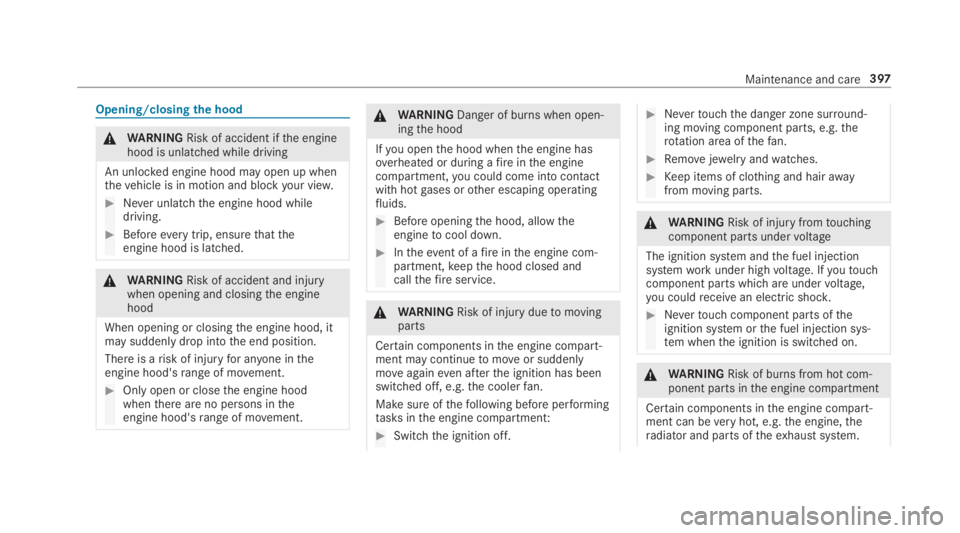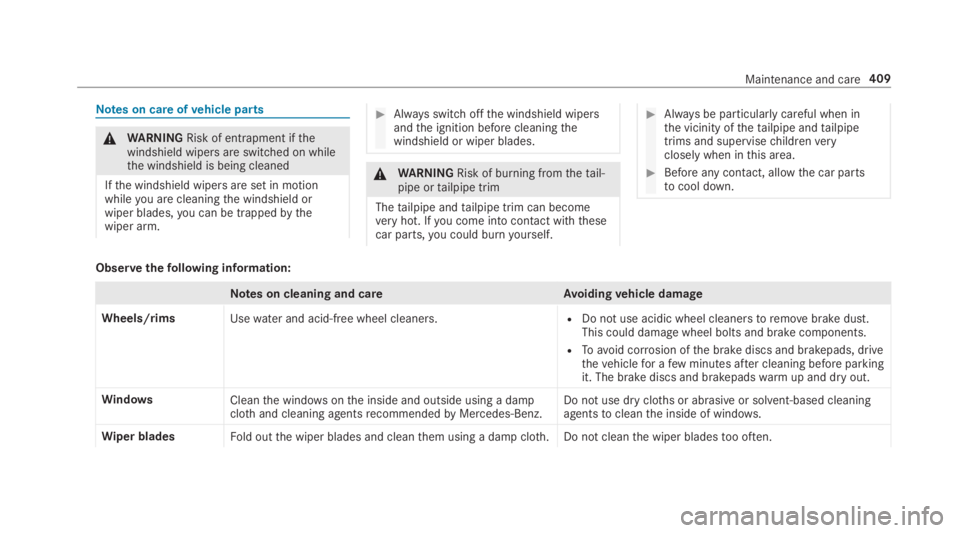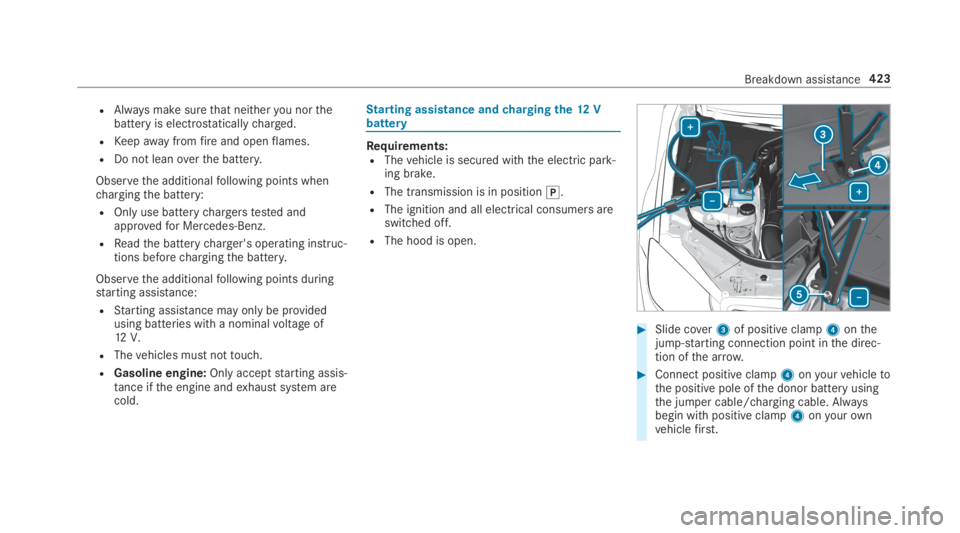2019 MERCEDES-BENZ S CLASS ignition
[x] Cancel search: ignitionPage 399 of 578

Opening/closingthe hood
&WARNINGRisk of accident ifthe enginehood is unlatched while driving
An unlocked engine hood may open up whenthevehicle is in motion and blockyour view.
#Never unlatchthe engine hood whiledriving.
#Beforeevery trip, ensurethattheengine hood is latched.
&WARNINGRisk of accident and injurywhen opening and closingthe enginehood
When opening or closingthe engine hood, itmay suddenly drop intothe end position.
There is arisk of injuryfor anyone intheengine hood'srange of movement.
#Only open or closethe engine hoodwhenthere are no persons intheengine hood'srange of movement.
&WARNINGDanger of burns when open‐ingthe hood
Ifyou openthe hood whenthe engine hasoverheated or during afireinthe enginecompartment,you could come into contactwith hotgases orother escaping operatingfluids.
#Before openingthe hood, allowtheenginetocool down.
#Intheevent of afireinthe engine com‐partment,keepthe hood closed andcallthefireservice.
&WARNINGRisk of injuryduetomovingparts
Certain components inthe engine compart‐ment may continuetomoveor suddenlymoveagaineven afterthe ignition has beenswitched off, e.g.the coolerfan.
Makesure ofthefollowing before performingtasks inthe engine compartment:
#Switchthe ignition off.
#Nevertouchthe danger zone surround‐ing moving component parts, e.g.therotation area ofthefan.
#Removejewelry andwatches.
#Keep items of clothing and hairawayfrom moving parts.
&WARNINGRisk of injuryfromtouchingcomponent parts undervoltage
The ignition system andthe fuel injectionsystemworkunder highvoltage. Ifyoutouchcomponent parts which are undervoltage,you couldreceivean electric shock.
#Nevertouch component parts oftheignition system orthe fuel injection sys‐tem whenthe ignition is switched on.
&WARNINGRisk of burns from hot com‐ponent parts inthe engine compartment
Certain components inthe engine compart‐ment can beveryhot, e.g.the engine,theradiator and parts oftheexhaust system.
Maintenance and care397
Page 400 of 578

#Allowthe enginetocool down and onlytouch component parts described inthefollowing.
&WARNINGRisk of injuryfrom usingthewindshield wipers whilethe engine hoodis open
Whenthe engine hood is open andthe wind‐shield wipers are set in motion,you can betrappedbythe wiper linkage.
#Always switch offthe windshield wipersand ignition before openingthe enginehood.
Plug-inhybrid:observethe notes inthe Supple‐ment. Otherwise,you mayfailtorecognize dan‐gers.
#Toopen:pull lever1toreleasethe hood.#Push handle1ofthe hood catch upwardsand liftthe hoodbyapproximately15in(40 cm).#Toclose:lowerthe hood and let itfall from aheight of approximately 8 in (20 cm).
#Ifthe hood canstill be lifted slightly,openthe hood again and close it with a little moreforce until it engages correctly.
398Maintenance and care
Page 402 of 578

RParkthevehicle on a level surface.
RLeavethe enginerunning at idle speed.
On-board computer:
,Service.Engine Oil Level
You will see one ofthefollowing messages inthe multifunction display:
#Measuring Engine Oil Level...: measurementofthe oil level is notyet possible.Repeattherequest after a maximum of 30 minutes' driv‐ing.
#Engine Oil Level OKandthe bar displayforindicatingthe oil level inthe multifunctiondisplay is green and is between "min" and"max":the oil level is correct.
#Engine Oil Level Add 1.0 landthe bar displayfor indicatingthe oil level inthe multifunctiondisplay is orange and is below "min": add1.1 US qt (1 liter) of engine oil.
#Reduce Engine Oil Levelandthe bar displayfor indicatingthe oil level inthe multifunctiondisplay is orange and is above"max": drain
offtheexcess engine oil. Consult aqualifiedspecialistworkshop.
#For Engine Oil Level Switch Ignition On:switch onthe ignitiontocheckthe engine oillevel.
#Engine Oil Level System Inoperative: sensordefective or not inserted. Consult aqualifiedspecialistworkshop.
#Engine Oil Level System Currently Unavail.:closethe hood.
Adding engine oil
&WARNINGRisk of burns from hot com‐ponent parts inthe engine compartment
Certain components inthe engine compart‐ment can beveryhot, e.g.the engine,theradiator and parts oftheexhaust system.
#Allowthe enginetocool down and onlytouch component parts described inthefollowing.
&WARNINGRisk offireand injury fromengine oil
If engine oil comes into contact withhotcomponent parts inthe engine compart‐ment, it may ignite.
#Make surethat no engine oil is spillednexttothefiller opening.
#Allowthe enginetocool off andthor‐oughly cleanthe engine oil from compo‐nent parts beforestartingthevehicle.
*NOTEEngine damagecausedbyanincorrect oilfilter, incorrect oil or addi‐tives
#Do not use engine oils or oilfilterswhich do not correspondtothe specifi‐cationsexplicitly prescribedfortheservice intervals.
#Do not alterthe engine oil or oilfilter inordertoachievelongerchange intervalsthan prescribed.
#Do not use additives.
400Maintenance and care
Page 411 of 578

Notes on care ofvehicle parts
&WARNINGRisk of entrapment ifthewindshield wipers are switched on whilethe windshield is being cleaned
Ifthe windshield wipers are set in motionwhileyou are cleaningthe windshield orwiper blades,you can be trappedbythewiper arm.
#Always switch offthe windshield wipersandthe ignition before cleaningthewindshield or wiper blades.
&WARNINGRisk of burning fromthetail‐pipe ortailpipe trim
Thetailpipe andtailpipe trim can becomeveryhot. Ifyou come into contact withthesecar parts,you could burnyourself.
#Always be particularlycareful when inthe vicinity ofthetailpipe andtailpipetrims and supervisechildrenveryclosely when inthis area.
#Before any contact, allowthe car partstocool down.
Observethefollowing information:
Notes on cleaning and careAvoidingvehicle damage
Wheels/rimsUsewater and acid-free wheel cleaners.RDo not use acidic wheel cleanerstoremovebrake dust.This could damage wheel bolts and brake components.
RToavoid corrosion ofthe brake discs and brakepads, drivethevehiclefor afew minutes after cleaning before parkingit. The brake discs and brakepadswarmup and dry out.
WindowsCleanthe windowsonthe inside and outside using a dampclothand cleaning agentsrecommendedbyMercedes-Benz.Do not use dry cloths or abrasive or solvent-based cleaningagentstocleanthe inside of windows.
Wiper bladesFold outthe wiper blades and cleanthem using a damp cloth.Do not cleanthe wiper bladestoo often.
Maintenance and care409
Page 419 of 578

#Pushthe plug of hose5intoflange6oftire sealant bottle1untilthe plug engages.
#Place tire sealant bottle1head downwardsintorecess2ofthe tire inflation compres‐sor.
#Removethe cap fromvalve7onthefaultytire.
#Screwfilling hose8ontovalve7.
#Insert connector4into a12V socket inyourvehicle.
#Switch onthe ignition.
#Press on and off switch3onthe tire infla‐tion compressor.The tire inflation compressor is switched on.The tire is inflated. First, tire sealant is pum‐ped intothe tire. The pressure may brieflyrisetoapproximately 500 kPa (5 bar/73 psi).
Do not switch offthe tire inflation compres‐sor duringthis phase.
#Letthe tire inflation compressorrunfor amaximum of eight minutes.The tire shouldthen haveattained a tirepressure of at least180 kPa (1.8 bar/26 psi).
If tire sealant leaksout, make sureyou cleantheaffected area asquickly as possible. It is prefera‐bletouse clearwater.
Ifyouget tire sealant onyour clothing, haveitcleaned as soon as possible with perchloroethy‐lene.
If a tirepressure of180 kPa (1.8 bar/26 psi)has not been attained after eight minutes:
#Switch offthe tire inflation compressor.
#Unscrewthefilling hose fromthevalve ofthefaulty tire.
Please notethat tire sealant may leak out whenunscrewingthefilling hose.
#Driveforwards orreverseveryslowlyforapproximately 33ft(10 m).
#Pump upthe tire again.After a maximum of eight minutesthe tirepressure must be at least180 kPa (1.8 bar/26 psi).
&WARNINGRisk of accident duetothespecified tire pressure not beingreached
Ifthe specified tire pressure is notreachedafterthe specified time,the tire istoo badlydamaged. The tire sealant cannotrepairthetire inthis instance.
Damaged tires and a tire pressurethat istoolow can significantly impair braking and han‐dlingcharacteristics.
#Do not continue driving.
#Consult aqualified specialistworkshop.
Breakdown assistance417
Page 425 of 578

RAlways make surethat neitheryou northebattery is electrostaticallycharged.
RKeepawayfromfireand openflames.
RDo not leanoverthe battery.
Observethe additionalfollowing points whenchargingthe battery:
ROnly use batterychargerstested andapprovedfor Mercedes-Benz.
RReadthe batterycharger's operating instruc‐tions beforechargingthe battery.
Observethe additionalfollowing points duringstarting assistance:
RStarting assistance may only be providedusing batteries with a nominalvoltage of12V.
RThevehicles must nottouch.
RGasoline engine:Onlyacceptstarting assis‐tance ifthe engine andexhaust system arecold.
Starting assistance andchargingthe12 Vbattery
Requirements:RThevehicle is secured withthe electric park‐ing brake.
RThe transmission is in position�].
RThe ignition and all electrical consumers areswitched off.
RThe hood is open.
#Slide cover3of positive clamp4onthejump-starting connection point inthe direc‐tion ofthe arrow.
#Connect positive clamp4onyourvehicletothe positive pole ofthe donor battery usingthe jumper cable/charging cable. Alwaysbegin with positive clamp4onyourownvehiclefirst.
Breakdown assistance423
Page 429 of 578

#Do not activatethe HOLD function.
#DeactivateActive Brake Assist (→page 200).
#Shiftthe automatic transmissiontoposition�\\.
#Releasethe electric parking brake.
&WARNINGRisk of accident duetolimi‐ted safety-related functions duringthetowing process
Safety-related functions are limited or no lon‐geravailable inthefollowing situations:
Rthe ignition is switched off.
Rthe brake system or powersteering sys‐tem is malfunctioning.
Rthe energy supply orthe on-board electri‐cal system is malfunctioning.
Whenyourvehicle isthentowedaway, signif‐icantly more effortmay berequiredtosteerand brakethan is normallyrequired.
#Use atow bar.
#Make surethatthesteering wheel canmovefreely, beforetowingthevehicleaway.
*NOTEDamageduetoexcessive tractivepower
Ifyou pullawaysharply,the tractive powermay betoo high andthevehicles could bedamaged.
#Pullawayslowly and smoothly.
Loading thevehiclefor transport
#Observethe notes ontowingaway(→page 426).
#Connectthetow bartothetowingeyetoloadthevehicle.
#Shiftthe automatic transmissiontoposition�\\.
%The automatic transmission may be lockedin position�]intheevent of damagetotheelectrics.Toshiftto�\\, providethe on-
board electrical system with power(→page 423).
#Loadthevehicle ontothe transporter.
#Shiftthe automatic transmissiontoposition�].
#Usethe electric parking braketosecurethevehicle againstrollingaway.
#Only securethevehiclebythe wheels.
Vehicles with ADS PLUS (Adaptive DampingSystem PLUS)
&WARNINGRisk of an accident whentransportingvehicles withAdaptiveDamping System PLUS
Thereduced dampingforces onthevehiclebeing transported can causethevehicle/trailer combinationtostarttoswing.
As aresult, when transportingvehicles withtheAdaptive Damping System PLUS,thevehicle/trailer combination maystarttoskid.Consequently,you could lose control ofyourvehicle.
#When transporting, ensurethat:
Breakdown assistance427
Page 432 of 578

*NOTEDamageduetoincorrect use ofthetowingeye
When atowingeye is usedtorecover avehi‐cle,thevehicle may be damaged inthe proc‐ess.
#Only usethetowingeyeto towawayortowstartthevehicle.
Tow-startingthevehicle (emergency enginestart)
*NOTEDamagetothe automatic trans‐mission dueto towstarting
The automatic transmission may be damagedinthe process oftowstartingvehicles withautomatic transmission.
#Vehicles with automatic transmissionmust not betowstarted.
#Vehicles with automatic transmission mustnot betow-started.
Electrical fuses
Notes on electrical fuses
&WARNINGRisk of accident and injurydueto overloaded lines
Ifyou manipulate or bridge afaulty fuse or ifyoureplace it with a fuse with a higheramperage,the electric line could beoverloa‐ded.
This couldresult in afire.
#Alwaysreplacefaulty fuses with speci‐fied new fuses containingthe correctamperage.
*NOTEDamagecausedbyincorrect fuses
Incorrect fuses may cause damagetoelectri‐cal components or systems.
#Only use Mercedes-Benz approvedfuses withthe correct fuserating.
Blown fuses mustbereplaced with fuses ofthesamerating, whichyou canrecognizebythecolor and fuserating. The fuseratings and fur‐
ther informationtobe observed are listed inthefuse assignment diagram.
*NOTEDamageor malfunctions causedbymoisture
Moisture may cause damagetothe electricalsystem or cause ittomalfunction.
#Whenthe fuse box is open, make surethat no moisture can enterthe fusebox.
#When closingthe fuse box, make surethatthe seal ofthe lid is positioned cor‐rectly onthe fuse box.
Ifthe newly inserted fuse also blows, havethecause traced andrectified at aqualified special‐istworkshop, e.g. an authorized Mercedes-BenzCenter.
Ensurethefollowing beforereplacing a fuse:
RThevehicle is secured againstrollingaway
RAll electrical consumers are switched off
RThe ignition is switched off
430Breakdown assistance